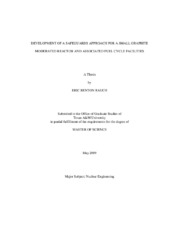| dc.description.abstract | Small graphite-moderated and gas-cooled reactors have been around since the beginning of the atomic age. Though their existence in the past has been associated with nuclear weapons programs, they are capable of being used in civilian power programs. The simpler design constraints associated with this type of reactor would make them ideal for developing nations to bolster their electricity generation and help promote a greater standard of living in those nations. However, the same benefits that make this type of reactor desirable also make it suspicious to the international community as a possible means to shorten that state?s nuclear latency. If a safeguards approach could be developed for a fuel cycle featuring one of these reactors, it would ease the tension surrounding their existence and possibly lead to an increased latency through engineered barriers. The development of this safeguards approach follows a six step procedure. First, the fuel cycle was analyzed for the types of facilities found in it and how nuclear material flows between facilities. The goals of the safeguards system were established next, using the normal IAEA standards for the non-detection and false alarm probabilities. The 5 MWe Reactor was modeled for both plutonium production and maximum power capacity. Each facility was analyzed for material throughput and the processes that occur in each facility were researched. Through those processes, diversion pathways were developed to test the proposed safeguards system. Finally, each facility was divided into material balance areas and a traditional nuclear material accountancy system was set up to meet the established safeguards goals for the facility. The DPRK weapons program is a great example of the type of fuel cycle that is the problem. The three major facilities in the fuel cycle, the Fuel Fabrication Facility, the 5 MWe Reactor, and the Radiochemical Laboratory, can achieve the two goals of safeguards using traditional methods. Each facility can be adequately safeguarded using methods and practices that are relatively inexpensive and can obtain material balance periods close to the timeliness limits set forth by the IAEA. The Fuel Fabrication Facility can be safeguarded at both its current needed capacity and its full design capacity using inexpensive measurements. The material balance period needed for both capacities are reasonable. For the 5 MWe reactor, plutonium production is simulated to be 6.7 kg per year and is on the high side of estimates. The Radiochemical Laboratory can also be safeguarded at its current capacity. In fact, the timeliness goal for the facility dictates what the material balance period must be for the chosen set of detectors which make it very reasonable. | en |


